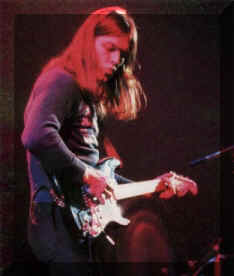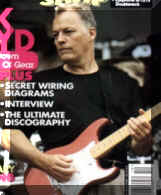
David's Page, my
tribute to Pink FLoyd 
Dave's main piece of of equipment is his Candy Apple Red Custom Shop 1957 U.S. Vintage Reissue Stratocaster. Actually, there are two of them. They are both fitted with EMG SA pickups, which are active (which means they contain their own preamp), instead of passive. The active pickups give higher output, clarity, and sustain. This sustain factor is due partially because they have a preamp, and also due to the fact that they can be placed closer to the string without interfering with the string's movement. In addition to the SAs, he has two sound modules, which replace the typical tone knobs. The knobs still say tone, but they're more than that. The EXG boosts the low and high frequencies. It would be sort of like setting your home equalizer into a V shape. The more you turn the knob, the more boost. The SPC does the same boosting, but only boosts the mid frequencies, and slightly reduces the highs. These modules help produce his tone, but aren't completly needed, it's just a lot simpler if you have them to get his tone.
His Strats are also modified with a shortened tremelo arm, which enables him to pick the strings while holding on the bar. This is something I've been wanting to try out for a while, as I hate the long thing Fender has stuck on there. Other than those modifications, the guitar is stock.
His blonde Telecaster, is modified, and has been through several mods over the years according to my research. As of right now I believe it's pretty much like stock. It's in a drop D tuning for Run Like Hell (which is DADGBE instead of EADGBE). He also has an Esqire (original style Telecaster with only a bridge pickup) that he bought off Seymour Duncan, the pickup designer, in the '70s. It had been fitted with a neck pickup from Duncan, Dave loved the sound so much he bought it. This is one of the guitars you hear on the albums The Wall, The Final Cut, and About Face (Dave's second solo album).
He has two Gibson J-200's, which are tuned DADGAD for Poles Apart, and the other standard. He also has a Chet Atkins Classical Acoustic/Electric nylon string guitar. During the 1987-1990 tour, he used a Takamine "The Natural" Acousitc.
His lap steels are Jedsen* made. Both are fit with EMG H pickups (which are EMG's S single coil pickup inside a humbucker cover). The lap steels are tuned EBEGBE (open E minor) for One of These Days, and the other is DGDGBE (basically open G) for Great Gig in the Sky and High Hopes. Notice that he leaves the high E tuned the same, so that he can do major and minor chords.
Dave uses GHS Boomers (.010, .012, .016, .028, .038, .048). He uses Ernie Ball Earthwood Lights for the acoustics.
*These are really Jedsens, and not Fenders. Jedsen was a Japanese company who made copy guitars in the early 70's. This may very well be a copy of a Fender 6 string lap steel, but it's not a Fender.
A - Marshall 4x12 cab loaded with Celestion 12"*
*The cabs are miced parallel using Shure SM-57's and Neumann U-87 Ai.
Note:There are two stacks, which each have a WEM and a Marshall. Then there are three doppolas, amped independant of each other.
What's a doppola?
A doppola is Dave's custom rotating speaker. If you know anything at all about Dave, you probably know that he's used the rotating speaker (a.k.a. leslie) for years. If you've seen Pompeii, you've seen an actual Leslie (they are the boxes with slits at the top). Dave used these for a long time. But the size of the stage and his rig eventually led him to the conclusion that the Leslies just were not big enough. So these doppolas were built. They have 2 speakers (I've heard they're 6" drivers), unlike a Leslie which has a horn driver and a 15" woofer.
What's a Leslie?
A Leslie is a speaker designed for organs. It has a horn driver, which has like a splitter on it into two horns, and this whole unit actually spins. It also has a 15" woofer, which points down facing a flat baffle which lies at an angle. The baffle spins to make the lower frequencies get the same effects as the higher. This system creates the vibrato effect. The vibrato (in it's true technical meaning) is to change not only the volume of the sound, but the pitch as well. Dave discovered that this effect in some areas gave a new dimension to the sound, as did many other guitarists. The success of Leslies led to things to simulate them so that you didn't need more equipment, such as the Uni-Vibe and others. But the sound is not the same, and so Dave uses both. He actually has several effects in his gear to get different rotating speaker sounds (the Leslie simulator, the Uni-Vibe, and the doppolas).
If you've ever seen Pompeii, or have seen such bands as the Allman Brothers, then you've probably seen them. They look like ordinary wooden boxes on the outside, except they have slits cut in the top, which is where the sound escapes. You will often times see mics pointed at these slits. Sometimes more than one mic too. To find out lots more on these cool little pieces of equipment,
The Amplifiers
*These are slaves that only amplify. They are wired stereo. The amp with no marking as to what it does is a spare.
Note:The stuff in parenthesis is what is marked on the front in plastic tape. The magazine lacks any real details to the setup of each amp.
The amps that lack tone control knobs are slaves which lack a preamp circuit. This is because the preamps of the amps with them go to both that amp and the coresponding slave amp. The slaves run only the doppolas and the talk box (referred to above as voice box). I'm not sure why this is done, but it is, and that basically how it works.
Visit Audio Brothers' site, and learn about HiWatt amps! Audio Brothers are the current owners of HiWatt, and are keeping the tradition alive
The Talk Box
You may have wondered, what's a talkbox? Well a talkbox is a horn driver which has surgical tubing going from the driver to your mouth. The sound then exits your mouth and is picked up by a microphone. Moving your mouth around makes the sounds you hear. This is how you can make it talk, and how it got it's name. It is powered by an amplifier, just like any other speaker device. That's what the amp marked "talkbox" is for. It's dedicated to the talkbox. I'm not sure how he turns in on or off, but he does. There's not much to say about it. It's pretty much a straight forward thing. The only thing to mention of importance would be that he more than likely runs a distortion before it, but I don't know which.
Signal Path Diagram
This is a diagram of where the guitar signal goes. Sorry for the somewhat confusing format. Maybe I'll fix it some day.
David Gilmour Pictures
 |
 |
END OF BIO-DATA & ABOUT PINK FLOYD MEMBER & ARTIST